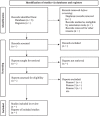Management and outcomes of chemotherapy-associated pneumoperitoneum in cancer patients: a scoping review protocol
- PMID: 38045559
- PMCID: PMC10688533
- DOI: 10.1097/SP9.0000000000000007
Management and outcomes of chemotherapy-associated pneumoperitoneum in cancer patients: a scoping review protocol
Abstract
Introduction: Pneumoperitoneum - free air within the peritoneal cavity - is often the result of bowel perforation, though other causes include residual postprocedural or postoperative air and barotrauma. In non-cancer patients, operative intervention is often required. Cancer patients, on the other hand, present a unique set of challenges as they usually have elevated risk of pneumoperitoneum from local radiation therapy, frequent endoscopic procedures, and tumor invasion. Factors such as malnutrition, neutropenia, chemotherapy, and steroid use make emergent surgery tenuous in cancer patients. There is a paucity of published literature on the management of pneumoperitoneum in patients actively undergoing chemotherapy. The main objective of this scoping review is to assess the presentation, management, and subsequent outcomes of this unique patient population.
Materials and methods: The authors will utilize the framework for performing scoping reviews as outlined by Arksey and O'Malley. They will perform the search for articles in three electronic databases (i.e. SCOPUS, PubMed, Embase) and relevant gray literature. Only articles available in English and published between 1999 and 2022 will be included. Inclusion criteria will be a known diagnosis of cancer, chemotherapy within 6 months of presentation, and imaging confirmation of pneumoperitoneum. Exclusion criteria will be cancer diagnosis at the time of presentation, perforation secondary to cancer itself, and chemotherapy greater than 6 months prior to presentation. A tailored extraction frame to extract relevant information from published articles that meet our inclusion criteria. The data using both descriptive statistics and thematic analysis of the main study questions.
Ethics and dissemination: Since the authors will not be collecting primary data, formal ethical approval is not required. They study findings will be disseminated through abstracts, conference presentations, and peer-reviewed publications.
Keywords: chemotherapeutic agent; chemotherapy; pneumoperitoneum; scoping review protocol; surgery.
Copyright © 2023 The Author(s). Published by Wolters Kluwer Health, Inc.
Conflict of interest statement
There are no conflicts of interest.
Figures
Similar articles
-
Chemotherapy-associated pneumoperitoneum in cancer patients: a scoping review.Ann Med Surg (Lond). 2024 Mar 25;86(5):2828-2835. doi: 10.1097/MS9.0000000000001998. eCollection 2024 May. Ann Med Surg (Lond). 2024. PMID: 38694333 Free PMC article.
-
Availability and Use of Essential Opioid Analgesics in Sub-Saharan Africa: A Scoping Review Protocol.Int J Surg Protoc. 2023 Feb 1;27(1):1-8. doi: 10.29337/ijsp.184. eCollection 2023. Int J Surg Protoc. 2023. PMID: 36789102 Free PMC article.
-
Protocol for a scoping review of research on abortion in sub-Saharan Africa.PLoS One. 2021 Jul 15;16(7):e0254818. doi: 10.1371/journal.pone.0254818. eCollection 2021. PLoS One. 2021. PMID: 34264992 Free PMC article.
-
Use of intraoperative haemostatic checklists on blood management in patients undergoing cardiac surgery: a scoping review protocol.BMJ Open. 2022 Aug 24;12(8):e064098. doi: 10.1136/bmjopen-2022-064098. BMJ Open. 2022. PMID: 36002220 Free PMC article.
-
Scoping review protocol: effectiveness of individualised nutritional care plans to reduce malnutrition during hospitalisation and up to 3 months after discharge.BMJ Open. 2019 Sep 5;9(9):e032615. doi: 10.1136/bmjopen-2019-032615. BMJ Open. 2019. PMID: 31492799 Free PMC article.
Cited by
-
Chemotherapy-associated pneumoperitoneum in cancer patients: a scoping review.Ann Med Surg (Lond). 2024 Mar 25;86(5):2828-2835. doi: 10.1097/MS9.0000000000001998. eCollection 2024 May. Ann Med Surg (Lond). 2024. PMID: 38694333 Free PMC article.
References
-
- Badgwell B, Feig BW, Ross MI, et al. . Pneumoperitoneum in the cancer patient. Ann Surg Oncol 2007;14:3141–3147. - PubMed
-
- Cho KC, Baker SR. Extraluminal air. Diagnosis and significance. Radiol Clin North Am 1994;32:829–844. - PubMed
-
- Mularski RA, Sippel JM, Osborne ML. Pneumoperitoneum: a review of nonsurgical causes. Crit Care Med 2000;28:2638–2644. - PubMed
-
- Stapakis JC, Thickman D. Diagnosis of pneumoperitoneum: abdominal CT vs. upright chest film. J Comput Assist Tomogr 1992;16:713–716. - PubMed
LinkOut - more resources
Full Text Sources


